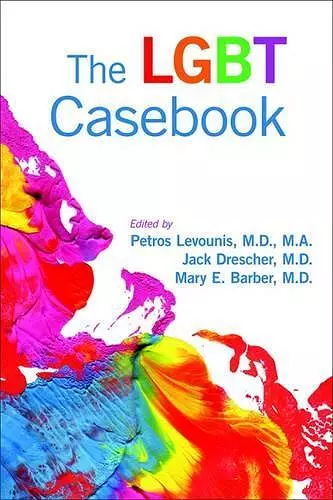The LGBT Casebook
Mary Barber editor Petros Levounis editor Jack Drescher editor
Format:Paperback
Publisher:American Psychiatric Association Publishing
Published:15th Jun '12
Currently unavailable, and unfortunately no date known when it will be back

This brilliantly edited volume is an essential reference and must read for all therapists who treat LGBT patients and their families. The unique issues LGBT patients bring to therapy are interwoven with the common clinical problems in every day practice as the case studies illustrate beautifully. A groundbreaking contribution to the field. Steven S. Sharfstein M.D., President and CEO, Sheppard Pratt Health System, Baltimore, Maryland
The LGBT Casebook provides a general overview and roadmap for clinicians new to treating LGBT individuals, and it deepens and updates knowledge for those already seeing these patients in their practices.
Even in today's more enlightened society, it takes courage for many lesbian, gay, bisexual, and transgender (LGBT) individuals to "come out of the closet" and embrace their sexual orientation and identity. Coming out, or facing internal and societal conflicts related to sexuality, involves a great deal of anxiety that can permeate other aspects of an LGBT individual's life—particularly when seeking psychiatric treatment. The goal of The LGBT Casebook is to help clinicians, trainees, and other mental health professionals address the mental health needs of LGBT people in the context of problems these individuals face in their everyday lives, including homophobia and discrimination.
The LGBT Casebook begins with five chapters devoted to basic concerns that affect LGBT populations, including coming out, heterosexist attitudes, the "don't ask, don't tell" mentality, legal issues, gay parenting, and sexual identity in patient-therapist relationships. In the rest of the book, clinician-authors present case studies of 20 patients with different DSM diagnoses, illuminating the impact of LGBT identity and illustrating a way of working with each presented patient. Features and benefits of The LGBT Casebook include:
• Insights into the unique problems LGBT people face in their everyday lives when compared with heterosexual individuals.
• Problems that are common to all LGBT individuals, such as the anxiety of being in the closet (hiding one's identity) or coming out (embracing one's identity).
• Practitioners with little experience in working with the LGBT population can gain a better understanding of psychiatric diagnoses within the context of an LGBT individual's everyday life.
• The book can be read cover-to-cover to gain insights into the full diversity of the LGBT population, or by specific chapters of interest to help with the diagnosis of a patient currently in treatment.
• A glossary at the back of the book defines both clinical and colloquial terms and phrases that clinicians and patients use to define themselves and their peers.
While The LGBT Casebook is the ideal general overview and roadmap for the clinician new to treating LGBT patients, it also provides new pearls...
This timely and sensible book seems to me to be a model of what a casebook should be. It is clear without being simple. It is relatively brief. It embodies good listening to patients. It is scientifically up-to-date and well written and edited. It provides reasonably detailed and thoughtful examples across a solid group of major psychiatric diagnoses – as well as across a few psychiatric and social categories other than diagnoses – and examples of integrated, educated, and helpful biopsychosocial consideration and treatment of people. I recommend this book to all psychiatrists, young and old, and to our mental health colleagues and students, particularly, but not limited to, those who are actively or might potentially work with LGBT (lesbian, gay, bisexual, and transgender) patients or clients.
-- Lawrence Hartmann, M.D. * The American Journal of Psychiatry *With this casebook, psychiatry finally finds itself walking toward – to meet and understand – the LGBT experience. The editors do a wonderful job of covering this rapidly changing cultural topography, ranging from more recent changes, such as the repeal of "don't ask don't tell," to the ongoing national debate concerning marriage equality, with its resulting legal uncertainties. Drs. Levounis, Drescher, and Barber cover the significant ground yet to be gained and address how this affects our clients and their families. As such, this book is a needed addition to help therapists deal with LGBT-related issues.
-- Genevieve Yancey, M.D. * The American Journal of Psychiatry *The variety and detail of the cases provide a living palette of LGBT experiences, one that offers a practical guide for the clinician rather than merely offering a theoretical framework for interaction with LGBT patients This volume should have broad appeal for all health care professionals given that it is difficult to imagine a clinician who will not at some point have LGBT patients or patients whose lives are touched by LGBT individuals. It should be required reading for trainees such as psychiatric residents.
-- James Krajeski, M.D., M.P.A. * Journal of Psychiatric Practice March 20ISBN: 9781585624218
Dimensions: 229mm x 152mm x 16mm
Weight: 522g
324 pages